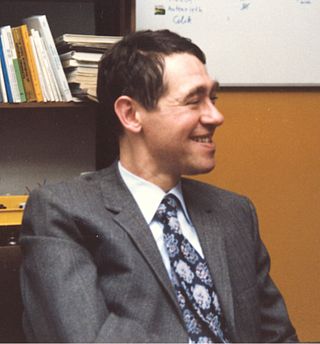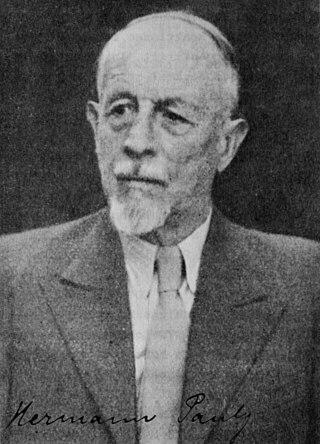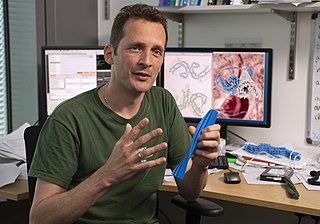Related Research Articles
Schering-Plough Corporation was an American pharmaceutical company. It was originally the U.S. subsidiary of the German company Schering AG, which was founded in 1851 by Ernst Christian Friedrich Schering. As a result of nationalization, it became an independent company. In 1971, the Schering Corporation merged with Plough, Inc. to form Schering-Plough. On November 4, 2009 Merck & Co. merged with Schering-Plough with the new company taking the name of Merck & Co.

Voigtländer was a significant long-established company within the optics and photographic industry, headquartered in Braunschweig, Germany, and today continues as a trademark for a range of photographic products.

Schering AG was a research-centered German multinational pharmaceutical company headquartered in Wedding, Berlin, which operated as an independent company from 1851 to 2006. In 2006, it was bought by Bayer AG and merged to form the Bayer subsidiary Bayer Schering Pharma AG, which was renamed Bayer HealthCare Pharmaceuticals in 2011. Schering was listed on the Frankfurt Stock Exchange and had 26,000 employees as of 2004.

Clocortolone (Cloderm) is a topical steroid. It is used in the form of an ester, clocortolone pivalate, and applied as a cream. It is used for the treatment of dermatitis and is considered a medium-strength corticosteroid. It is unusual among steroids in that it contains a chlorine atom and a fluorine atom.

Ernst Christian Friedrich Schering was a German apothecary and industrialist who created the Schering Corporation. The company split into Schering AG and Schering-Plough after US assets were seized during World War II.

Johann Hermann Wolfgang Mulzer is a German organic chemist, best known for his work in total synthesis. Since 1996, he has been a professor of chemistry at the University of Vienna.

Clemizole is an H1 antagonist.

Jenapharm is a pharmaceutical company from Jena, Germany. Founded in 1950 in East Germany, the company focused from the beginning on the production and development of steroids. Due to the economic circumstances of the Eastern Bloc, the company initially used a unique process of steroid synthesis starting from hog bile, however this method was abandoned a decade later in favor of total synthesis. Initially the company produced a wide range of generic steroids, including corticosteroids, but later on it focused on anabolic steroids, estrogens and progestins.

Bayer AG is a German multinational pharmaceutical and biotechnology company and is one of the largest pharmaceutical companies and biomedical companies in the world. Headquartered in Leverkusen, Bayer's areas of business include: pharmaceuticals, consumer healthcare products, agricultural chemicals, seeds and biotechnology products. The company is a component of the EURO STOXX 50 stock market index.
Repros Therapeutics Inc. (Nasdaq: RPRX), was a US-based development stage biopharmaceutical company headquartered in The Woodlands, Texas. Founded in 1987 as Zonagen, it focused on the development of oral small molecule drugs to address major unmet medical needs in male and female health. Joseph S. Podolski was the CEO of this company.

Atotech is an international speciality chemicals and equipment company. It provides chemistry and equipment for companies that manufacture printed circuit boards, IC-substrates and semiconductors; and also provides specialty chemicals and equipment for decorative and functional surface finishing in the automotive, construction, furniture and other industries.
Gustav Ehrhart was a German chemist. He synthesized the first fully synthetic opioid analgesic, methadone, together with Max Bockmühl.
Gerhard Raspé was a Romanian-born German organic chemist, who served as research director at Schering AG and a member of the company's executive board.
Anton Marxer was a German veterinarian, chemist and bacteriologist. He succeeded Hans Aronson as director of the Department of Bacteriology at the pharmaceutical company Schering AG in 1909.

Hermann Pauly was a German chemist and inventor. He is known for the Pauly reaction, a chemical test used for detecting the presence of tyrosine or histidine in proteins.
Rainer Philippson was a German organic chemist. He is known for inventing and patenting the synthesis of clocortolone with Emanuel Kaspar in 1973. The original assignee of the patent was Schering AG. Philippson held a PhD (Dr.rer.nat.) and worked as a researcher at the German Academy of Sciences at Berlin in the 1950s and 1960s. In the 1960s, he defected to West Germany and joined Schering AG as a researcher. Philippson was also a co-inventor of several other patents held by Schering.
Horst Peissker or Horst Peißker was a German biochemist, inventor and business executive in the pharmaceutical and chemical industry. He was a researcher at Schering AG, and was a member of the company's senior management as head of its research and production facility in Wolfenbüttel.

Sjors Hendrik Willem ScheresFRS is a Dutch scientist at the MRC Laboratory of Molecular Biology Cambridge, UK.

Bernardus Johannes Godefridus Scheres (Ben) Scheres is a Dutch developmental biologist. He is Professor of Plant Developmental Biology at Wageningen University.
References
- ↑ Process for the preparation of 9alpha-chloro-11beta-hydroxy steroids , retrieved 2015-12-07
- 1 2 Genealogisches Handbuch des Adels , vols. 92–111, p. 437, C.A. Starke, 1989